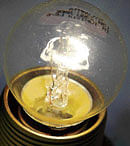New light on next-gen LEDs

A next-generation LED production technology will eventually see today’s compact fluorescents going the same way as Thomas Edison’s incandescent bulbs.
Humphreys's interest in gallium nitride (GaN) goes back to the mid-90s when he first investigated the man-made material with an electron microscope. As well as emitting a brilliant light, it is an important semiconducting material for high-power transistors. Now, through the Cambridge Centre for Gallium Nitride and backed by Engineering and Physical Sciences Research Council funding, cutting edge research is showing what GaN is really capable of. Working with GaN-based light emitting diodes requires highly specialist equipment capable of growing the semiconductor crystals.
“Something like 90 per cent of commercial LEDs are grown on two-inch diameter sapphire wafers," says Humphreys. "To grow gallium nitride you have to grow it at about 1,000°C." Indium is added for a brilliant visible light – 10 per cent for a blue light, 20 per cent for green – with a phosphor coating on the LED changing this to white.
But why use sapphire in the first place? It's an unreactive base material stable at the high gas temperatures used to form the GaN crystals. Humphreys says that a two-inch sapphire wafer costs $50 with an industry standard six-inch silicon wafer costing $15. If you try and deposit GaN onto a silicon wafer to save money, differential thermal expansions between the materials result in a bent wafer with numerous defects in the neat rows of 1mm2 LEDs. But by using an additional "compressive" layer of aluminium gallium nitride and other techniques, Humphreys has successfully overcome these problems.
The maths now starts to work in his favour even though, at 58%, the LED internal quantum efficiency currently lags behind the 70% of the sapphire-based equivalents. "Effectively, you get at least as 10 times as many useful LEDs from a six-inch wafer as from a two-inch wafer." He also reckons the production costs for a finished LED lightbulb may fall by a factor of five.
LEDs offer three times the efficiency of compact fluorescent lamps and 12 times that of incandescents. They also switch on instantly, are dimmable, and last for 100,000 hours. “We think we can mimic the visible spectrum of sunlight and get natural lighting," adds Humphreys. "If we can get the cost down, they'll just be everywhere in the world.”
Matt Prescott, founder of the Ban the Bulb campaign would like to see more research into LEDs as a replacement for energy-wasting incandescent bulbs and halogen lamps, and even compact fluorescents. Today, you can buy a low-energy bulb for less than 50p. “We need a similar thing to happen to LEDs where they're just made on a massive scale and go from being £10 or £20 now maybe down to £1,” says Prescott. "The government should send a clear signal that LEDs are the future.”
Deccan Herald is on WhatsApp Channels| Join now for Breaking News & Editor's Picks